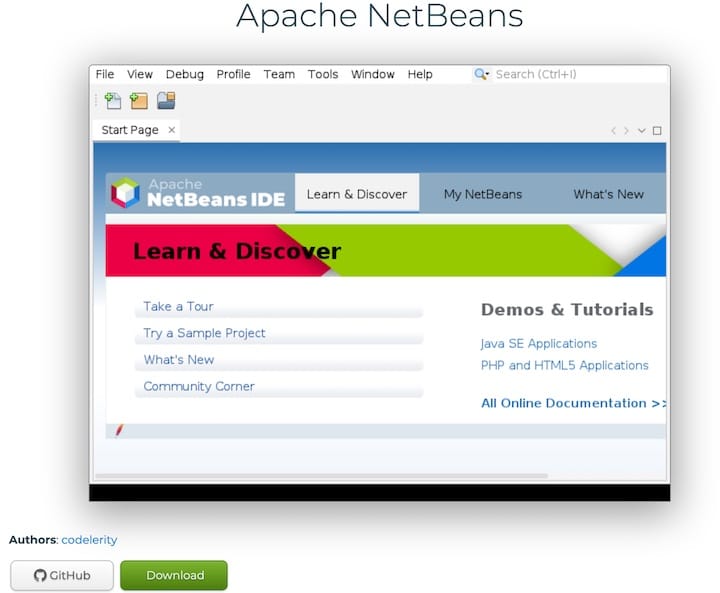How To Install Apache NetBeans on Ubuntu 24.04 LTS

Apache NetBeans is a powerful and versatile integrated development environment (IDE) that has become an essential tool for developers across various programming languages. Whether you’re a seasoned programmer or just starting your coding journey, installing Apache NetBeans on your Ubuntu system can significantly enhance your development workflow. This comprehensive guide will walk you through the process of installing Apache NetBeans on Ubuntu, providing you with multiple methods and detailed instructions to ensure a smooth setup.
What is Apache NetBeans?
Apache NetBeans is an open-source IDE primarily designed for Java development but also supports other programming languages such as HTML5, PHP, C++, and JavaScript. It provides a robust set of tools for coding, debugging, and project management, making it a popular choice among developers worldwide.
Key features of Apache NetBeans include:
- Intelligent code editing with syntax highlighting and code completion
- Powerful debugging tools
- Built-in support for version control systems like Git
- Cross-platform compatibility
- Extensive plugin ecosystem for customization
With its user-friendly interface and comprehensive feature set, Apache NetBeans streamlines the development process, allowing programmers to focus on writing high-quality code efficiently.
System Requirements
Before proceeding with the installation of Apache NetBeans on Ubuntu, it’s essential to ensure that your system meets the necessary requirements. While NetBeans is generally not resource-intensive, having a system that meets or exceeds these specifications will ensure optimal performance:
- Ubuntu version: 18.04 LTS or later (20.04 LTS and 22.04 LTS are recommended)
- Processor: 1.8 GHz dual-core CPU or better
- Memory: 4 GB RAM (8 GB or more recommended for larger projects)
- Disk space: At least 2.5 GB of free disk space
- Display: 1024×768 resolution or higher
Additionally, you’ll need to have Java Development Kit (JDK) installed on your system, as NetBeans is primarily a Java-based IDE.
Preparing Your Ubuntu System
Before installing Apache NetBeans, it’s crucial to prepare your Ubuntu system by updating existing packages and installing the necessary prerequisites. Follow these steps to ensure your system is ready:
1. Update System Packages
Open a terminal and run the following commands to update your system’s package list and upgrade existing packages:
sudo apt update
sudo apt upgrade2. Install Java Development Kit (JDK)
Apache NetBeans requires Java Development Kit to function properly. To install OpenJDK, which is the open-source implementation of the Java Platform, use the following command:
sudo apt install default-jdk3. Verify Java Installation
After the installation is complete, verify that Java is correctly installed by checking its version:
java -versionThis command should display information about the installed Java version.
Methods to Install Apache NetBeans
There are several methods to install Apache NetBeans on Ubuntu, each with its own advantages. We’ll cover three primary installation methods:
- Installing via Snap
- Manual installation
- Installing via Flatpak
Choose the method that best suits your needs and system configuration.
Installing Apache NetBeans via Snap
Snap is a software deployment and package management system developed by Canonical for Linux operating systems. Installing Apache NetBeans via Snap is one of the easiest and most straightforward methods.
Step-by-step installation process:
- Open a terminal window.
- Ensure that Snap is installed on your system by running:
snap versionIf Snap is not installed, you can install it with:
sudo apt install snapd - Install Apache NetBeans using the following command:
sudo snap install netbeans --classicThe
--classicflag is necessary because NetBeans requires full system access. - Wait for the installation to complete. Snap will download and install NetBeans along with its dependencies.
Verifying the installation:
To verify that Apache NetBeans has been installed correctly, you can:
- Check the installed version by running:
snap list netbeans - Launch NetBeans from the application menu or by typing
netbeansin the terminal.
If NetBeans launches successfully, you’ve completed the installation via Snap.
Installing Apache NetBeans Manually
For users who prefer more control over the installation process or need a specific version of NetBeans, manual installation is an excellent option. Follow these steps to install Apache NetBeans manually:
1. Downloading the NetBeans installer
- Visit the official Apache NetBeans download page.
- Choose the latest stable version of NetBeans (e.g., Apache NetBeans 23).
- Download the .sh installer file for Linux.
2. Making the installer executable
Once the download is complete, you need to make the installer executable. Open a terminal, navigate to the directory containing the downloaded file, and run:
chmod +x netbeans-12.6-bin-linux-x64.shReplace “netbeans-12.6-bin-linux-x64.sh” with the actual name of the downloaded file if it’s different.
3. Running the installer
Execute the installer by running:
./netbeans-12.6-bin-linux-x64.sh4. Configuring installation options
The NetBeans installer will launch, guiding you through the installation process:
- Read and accept the license agreement.
- Choose the installation directory (the default is usually fine).
- Select the JDK installation to use with NetBeans.
- Choose which components to install (you can select all for a complete installation).
- Review your choices and click “Install” to begin the installation.
5. Completing the installation process
The installer will now copy files and set up NetBeans on your system. Once completed, you’ll see a confirmation message. You can then launch NetBeans from the application menu or by running netbeans in the terminal.

Installing Apache NetBeans via Flatpak
Flatpak is another popular package management system for Linux that offers sandboxed applications. Here’s how to install Apache NetBeans using Flatpak:
1. Setting up Flatpak on Ubuntu
If Flatpak is not already installed on your system, you can install it by running:
sudo apt install flatpak
sudo apt install gnome-software-plugin-flatpak
flatpak remote-add --if-not-exists flathub https://flathub.org/repo/flathub.flatpakrepoAfter installation, restart your system to ensure all changes take effect.
2. Installing NetBeans using Flatpak
Once Flatpak is set up, you can install Apache NetBeans with the following command:
flatpak install flathub org.apache.netbeansFollow the prompts to complete the installation.
3. Launching NetBeans from Flatpak
To launch NetBeans installed via Flatpak, use the command:
flatpak run org.apache.netbeansAlternatively, you can find and launch NetBeans from your application menu.
Post-Installation Configuration
After successfully installing Apache NetBeans, there are a few configuration steps you might want to consider to optimize your development environment:
1. Setting up project directories
Create a dedicated directory for your NetBeans projects. You can do this through the NetBeans interface:
- Go to Tools > Options > Miscellaneous > Files
- Set your preferred project folder in the “Projects Folder” field
2. Configuring plugins and extensions
NetBeans offers a wide range of plugins to extend its functionality:
- Go to Tools > Plugins
- Browse available plugins and install those relevant to your development needs
- Popular plugins include additional language support, version control integrations, and code analysis tools
3. Customizing the IDE interface
Tailor the NetBeans interface to your preferences:
- Adjust the layout: Window > Reset Windows
- Customize keyboard shortcuts: Tools > Options > Keymap
- Change the look and feel: Tools > Options > Appearance
Troubleshooting Common Installation Issues
While installing Apache NetBeans on Ubuntu is generally straightforward, you might encounter some issues. Here are solutions to common problems:
1. Addressing Java-related problems
If NetBeans fails to start due to Java issues:
- Ensure you have the correct version of JDK installed
- Verify Java is in your system’s PATH by running:
echo $PATH - If necessary, set the JAVA_HOME environment variable:
export JAVA_HOME=/path/to/your/jdk export PATH=$PATH:$JAVA_HOME/bin
2. Resolving dependency conflicts
If you encounter dependency issues during installation:
- Ensure your system is up to date:
sudo apt update && sudo apt upgrade - Install any missing dependencies manually
- If using Snap or Flatpak, try removing and reinstalling the package
3. Fixing permission issues
For permission-related problems:
- Ensure you have write permissions in the installation directory
- Run the installer with sudo if necessary (for manual installation)
- Check file ownership and permissions of the NetBeans directory
Congratulations! You have successfully installed NetBeans. Thanks for using this tutorial for installing the Apache NetBeans IDE on Ubuntu 24.04 LTS system. For additional help or useful information, we recommend you check the official Apache website.